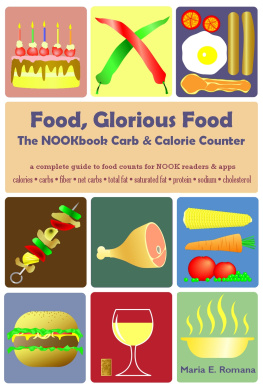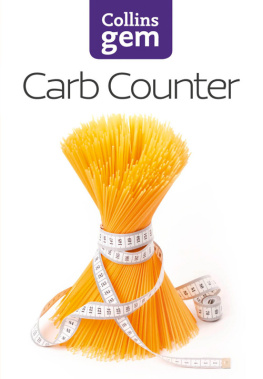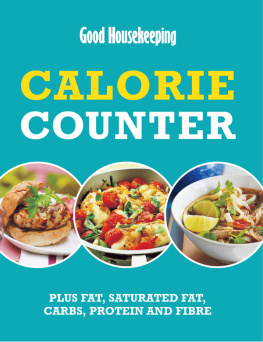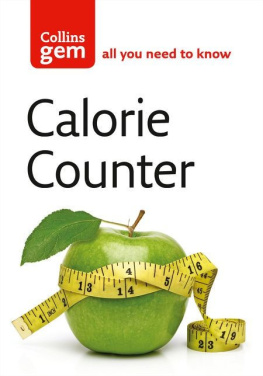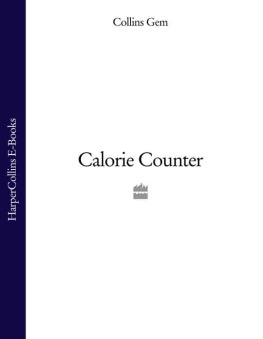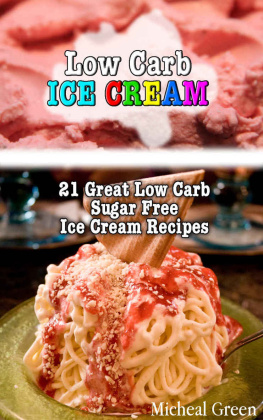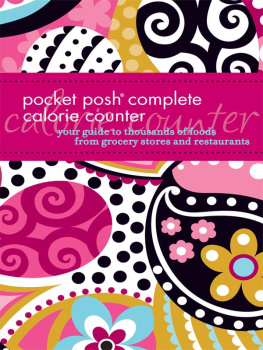Food, Glorious Food: The NOOKbook Carb & Calorie Counter, a complete guide to food counts for NOOK readers & apps
calories carbs fiber net carbs total fat saturated fat protein sodium cholesterol
by
Maria Elizabeth Romana
Copyright 2011
At Your Command, Inc.
Durham, NC, USA
MariaRomana.com
1st Edition
Nutrient values and serving sizes contained in this volume are based on the 2010 USDA National Nutrient Database for Standard Reference, Release 23. To learn more about this database, please visit the U.S. Department of Agriculture, Agricultural Research Service website, Nutrient Data Laboratory Home Page.
License Notes
All rights reserved. Without limiting the rights under copyright reserved above, no part of this publication may be reproduced, stored in or introduced into a retrieval system, or transmitted, in any form, or by any means (electronic, mechanical, photocopying, recording, or otherwise) without the prior written permission of the copyright owner and publisher of this book. This ebook is licensed for your personal enjoyment only. It may not be resold or given away to other people, except as your ereaders lending function allows. If youre reading this book and did not purchase it, then you should purchase your own copy (see MariaRomana.com for sellers). Thank you for respecting the authors work.
Table of Contents
Introduction
When I was in the sixth grade, I was cast in the local high school production of the musical Oliver!. Yeah, you got itI became one of the starving boys at the orphanage, which was ironic, considering I was a rather chubby little girl, sporting Coke-bottle eyeglasses and metal braces on my teeth. But with my active imagination, I was able to see myself in the role, and relished in belting out the opening number, Food, Glorious Food. I suppose thats why, thirty years later, the song kept running through my head while I was writing a series of articles about the nutritional content of various foods for a popular health website.
During the process of writing the articles, I became intimately familiar with the food counts database maintained by our own federal department of agriculture, the USDA, and their data branch, the Agricultural Research Service. As the popularity of ebooks and ebook readers grew, I realized that a version of this data, specially formatted for electronic readers, would be useful to many. I expect it will be particularly helpful to those of you who are accustomed to lugging around a thick paperback of food counts packed tightly into narrow rows and columns. Food, Glorious Food uses a resizable font and reflowable text, listing each food item out separately, just as it would appear on a standard nutrition label. With Food, Glorious Food on your reader, you can leave your clunky paperbackand your reading glassesat home.
How to Use this Guide
The book is divided into chapters by broad food categories (beef, dairy, vegetables, etc.), which are listed in the Table of Contents. At the beginning of each chapter, there is an alphabetical index of the items in that chapter, with a selection of serving sizes for each item. There is also a complete index at the beginning of the book (right after this how-to section) that lists all the items in the book in alpha order. Both of these indexes and the Table of Contents are hot-linked to the more detailed information. Using a combination of the indexes, the Table of Contents, and your ereaders search function, you should be able to find whatever you are looking for.
Here are some search tips to make it even easier:
- If youre looking for an item with an uncommon name like chokecherries, pastrami, or Milky Way bars, just use the ereader search function. You should be given a list or taken directly to one of only a few entries for that item.
- If youre looking for something more common, like carrots or chocolate, first use the Table of Contents to jump to either the main index or to the appropriate chapter index for that item (like Vegetables for carrots or Sweets for chocolate). From there, you can visually scan for the item you want or use the search function to locate it.
- Most of the entries are listed less specific to more specific, so for example, you will find carrots, raw rather than raw carrots, and cake, chocolate rather than chocolate cake.
- Brand-name and restaurant foods are usually grouped together under the brand name, so if youre looking for McDonald's hamburgers, youll find them under McDonald's, rather than hamburgers.
Heres an example. Suppose you were looking for the listing for saltines. Searching for saltines in the main index would bring you to a listing like this:
Crackers, Rusk toast
Crackers, Rye
Crackers, Saltines
Crackers, Snack
Crackers, Standard snack-type
Crackers, Wheat
Clicking on the 255-258 next to the Saltines would take you to the chapter index in the Baked Goods chapter, and present you with this:
Crackers, saltines (includes oyster, soda, soup):
[0.5 oz / 14 g]
[2.5 oz / 70 g]
[0.5 oz / 15 g]
[0.1 oz / 3 g]
[0.4 oz / 10 g]
[< 0.1 oz / 1 g]
[0.2 oz / 6 g]
[1.6 oz / 45 g]
If you were specifically looking for oyster crackers and planned to eat a pretty hefty serving, you would choose the last entry, 1 cup oyster crackers, and click on those words. That would bring you to a table like the one below, which closely matches the layout of standard nutritional labels:
Crackers, saltines (includes oyster, soda, soup)
Serving Size: 1 cup oyster crackers [1.6 oz, 45 g]
| Calories | 189.5 |
| Fats, Total | 4.0 g |
| Sat. Fats | 0.9 g |
| Cholesterol | 0 mg |
| Sodium | 502 mg |
| Carbohydrate | 33.5 g |
| Fiber | 1.3 g |
| Sugars | 1.0 g |
| Net Carbs | 32.1 g |
| Protein | 4.3 g |
Now all you have to do is multiply the single serving size by the amount youre eating. For example, if you planned to eat half a cup of oyster crackers instead of the whole cup, you would just divide the amounts shown by two. If you are sampling this book, go ahead and click on some of the links above and see how it works.
Notes:
Sat. Fats = grams of saturated fat, a subset of total fats
Carbohydrate = total grams of carbohydrate, including fiber, sugars, and starches
Fiber = grams of dietary fiber
Sugars = total mono and disaccharides
Net Carbs = total carbohydrate less dietary fiber (this is the measure used by most low-carb diets to count carbohydrate intake)
Active Index
A
Abiyuch
Acerola
Acerola juice
Acorn flour
Acorn stew
Acorns
Adobo fresco
Agave
Agutuk
Alcohol
Alfalfa seeds
Allspice
Almond butter
Almond paste
Almonds
Amaranth
Amaranth leaves
Animal fat
Anise seed
Antelope
Apple juice
Applebee's
Apples, Canned
Apples, Dehydrated
Apples, Dried
Apples, Frozen
Apples, Raw
Applesauce
Apricot nectar
Apricots, Canned, Extra heavy syrup pack
Apricots, Canned, Extra light syrup pack
Apricots, Canned, Heavy syrup
Apricots, Canned, Heavy syrup pack
Apricots, Canned, Juice pack
Apricots, Canned, Light syrup pack
Apricots, Canned, Water pack
Apricots, Dehydrated
Apricots, Dried
Apricots, Frozen
Apricots, Raw
Arrowhead
Arrowroot
Arrowroot flour
Artichokes
Arugula
Ascidians
Asparagus, Canned
Next page
